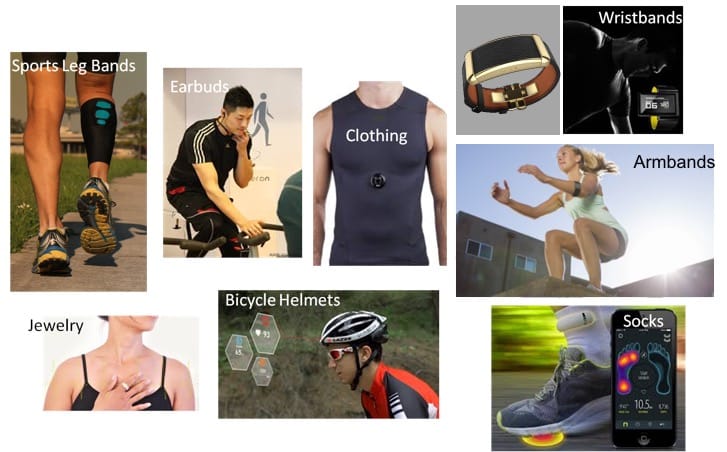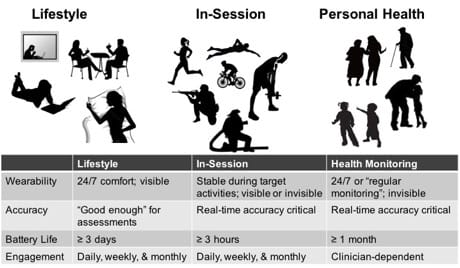Why Accuracy Matters in Biometric Wearables
The accuracy of biometric wearable devices is getting a significant amount of attention these days. Fitness bands, smartwatches, biometric earbuds and other devices claim that they can measure your heart rate, steps, cadence, and calories burned. Moreover, manufacturers of biometric wearables are promising of next-gen products having more advanced metrics, such as heart rate variability, cardiac efficiency, and even blood pressure. The claims are big and the stakes are high, but the reality is that the industry is struggling to generate these metrics with “good enough” accuracy to impact fitness training and health management.
In this three-part blog series, we will “peek behind the curtain” of biometric wearables and explore why and how accuracy in biometric wearables is developing into a critical factor in the wearables market. This series will cover:
Accuracy in biometric wearables is critical for enabling the most compelling use cases in sports, fitness, and health. Let’s take a deep-dive at Why Accuracy Matters…
So why does accuracy matter at all for biometric wearables?
To answer this question, it’s important to note that in general there are two primary groups that care about accuracy:
1. The companies that make the biometric wearable devices – the large consumer electronics OEM’s and wearable device makers, like Jabra, Sony, LG, Mio, Garmin, Fitbit, Apple, and hundreds more.




2. The people that use the biometric wearable devices – and this is a wide range of people. For example, some are weekend warriors trying to improve their performance, some are more interested in tracking their activity and lifestyle on a daily basis, and others are trying to monitor a specific health condition impacting their lives. This group also includes fitness trainers, physicians, and coaches who manage the training or therapy of their clients.

For consumer electronics companies, accuracy in biometric wearables matters for a number of reasons, including:
- Consumer Trust – Users of these devices need to have confidence that the data coming off the device is accurate in order for them to believe that the device is actually delivering on the promises made in the device’s marketing and advertising. For example, if a device claims to be able to track heart rate, activity levels, and calories burned during high-intensity exercises, but the device’s heart rate monitor has difficulty removing motion “noise” from the sensor, it’s not going to deliver on that promise. This obviously disappoints consumers, leads to negative product reviews that hinder future sales, and the products end up in the drawer where devices go to die.
- Product Roadmap – Nearly all biometric wearables today use an optical methodology called PPG, which shines light into the body and measures the light that bounces back – more detail here. While PPG is really hard to get right, when you do get it right, it can be very powerful. A high-quality PPG signal is foundational to heart rate as well as many advanced biometrics, such as breathing rate, cardiac efficiency, blood pressure, and more. In other words, if you start off with a mediocre or poor PPG signal, you may get heart rate for some use cases that do not involve much physical movement, but you will never get to the more advanced metrics that consumer experiences are demanding today and in the future.
- Risk Management – As with any consumer electronics device, there are risks to consider with these devices, including brand risk, revenue risk, and legal risk. In the context of wearables, the methods to mitigate these risks are different than most consumer technologies, because they involve the human body and indications of personal health that require a high degree of biometric accuracy to mitigate these risks. When manufacturers market their products with images of athletes wearing them during aggressive exercise, and if these products don’t deliver accuracy during these exercises, they expose themselves to these risks. Research shows that PPG technology that doesn’t account for motion and environmental noise generates inaccurate biometrics during aggressive exercise, and the performance is further affected by one’s body shape, size, skin color, and physiology. Mitigating these risks demands advanced PPG technology, capable of active signal characterization, that has passed extensive validation testing in the desired product form-factor and under the intended use case, whether that’s running a marathon or typing on a computer.
For the people who use biometric wearables, accuracy matters for some similar and some different reasons:
- Products and promises you can believe in – In general you buy a biometric wearable device to accomplish a goal of some kind – running a 5K faster, improving their overall fitness, managing a health condition, or whatever it might be. If the device is producing unbelievable data (not in a good way) or vanity metrics, you either won’t trust the data, won’t trust the product, and/or won’t see as much value from the product.
- Achieving goals – On the other hand, if the devices are producing relevant data that is providing real insights into fitness and health, then you are much more likely to be interested. You can learn what you’re doing right or wrong on your way to achieving your goals. It becomes a good habit and routine that has the potential for real impact.
- Get better over time – In addition to data from individual sessions or days, accurate biometrics enable ongoing insights that can provide relevant guidance on how to continue progress toward goals. For example, if you start exercising to lose weight, you may not see weight loss happen in the first few weeks (that will come later), but you will see a lowering of your resting heart rate and an increase in your cardiac efficiency in the first few weeks. These biomarkers may not be the end goal, but they’re milestones showing you that you’re going in the right direction. Valencell has done research studies on this topic, which you can see in slides 10, 19-22.
Lastly, it’s important to understand that the level of accuracy needed for different devices varies by the use cases it’s intended to support. There are no “one-size-fits-all” wearables that can support everything from triathlon training to 24/7 heart rate tracking to health condition monitoring. So the question is what accuracy is good enough for what you want to do with the device?
There are many different use cases, but this chart gives a summary of a few categories of use cases and the high-level requirements for each kind of device:
